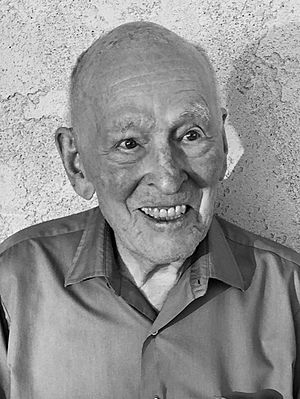Paul D. Boyer facts for kids
Quick facts for kids
Paul D. Boyer
|
|
|---|---|

Boyer in 2016
|
|
| Born | July 31, 1918 Provo, Utah, U.S.
|
| Died | June 2, 2018 (aged 99) Los Angeles, California, U.S.
|
| Alma mater | |
| Known for |
|
| Spouse(s) | Lyda Whicker |
| Awards |
|
| Scientific career | |
| Fields | |
| Institutions |
|
Paul Delos Boyer (July 31, 1918 – June 2, 2018) was an American biochemist. He was a chemistry professor at the University of California Los Angeles (UCLA). In 1997, he shared the Nobel Prize in Chemistry. This award was for his research on how enzymes help create adenosine triphosphate (ATP). This process is called ATP synthase. He shared the prize with John E. Walker. Paul Boyer was the first Nobel winner born in Utah. The other part of the prize that year went to Jens Christian Skou. Skou discovered the Na+/K+-ATPase, another important enzyme.
Contents
Early Life and School
Paul Boyer was born in Provo, Utah. He went to Provo High School. There, he was active in student groups and the debating team. He earned a science degree in chemistry in 1939. This was from Brigham Young University.
He then received a scholarship for graduate studies. Five days before moving to Wisconsin, Paul married Lyda Whicker in 1939. They were married for almost 80 years. They had three children together.
His Amazing Career
After getting his Ph.D. in biochemistry in 1943, Paul Boyer worked at Stanford University. He helped with a project related to the war. This project focused on making blood transfusions safer.
Later, he started his own research at the University of Minnesota. He used new ways to study how enzymes work. In 1955, he received a special Guggenheim Fellowship. This allowed him to work with Professor Hugo Theorell. They studied how alcohol is processed in the body.
In 1963, he became a professor at University of California, Los Angeles. In 1965, he helped start the Molecular Biology Institute. He led the creation of its building and a new Ph.D. program. Even with these big tasks, his research stayed very creative.
Understanding ATP Synthesis
Paul Boyer's most famous work was on ATP synthase. This is a special enzyme that makes ATP. ATP is like the energy currency of cells. He suggested three main ideas about how ATP is made:
- Energy is mostly used to release ATP, not just to form it.
- Three identical parts of the enzyme change shape in a specific order.
- A smaller inner part of the enzyme spins. This spinning causes the changes in the outer parts. These changes help make ATP.
Paul Boyer also helped share scientific knowledge. He was an editor for the Annual Review of Biochemistry. He also edited a famous series called "The Enzymes."
Later Life and Passing
Paul Boyer passed away on June 2, 2018. He was 99 years old. He died at his home in Los Angeles.
Awards and Special Recognitions
Paul Boyer received many important awards for his work.
| Year | Organization | Award Title |
|---|---|---|
| 1955 | American Chemical Society | Paul-Lewis Award in Enzyme Chemistry |
| 1955 | John Simon Guggenheim Memorial Foundation | Guggenheim Fellowship |
| 1968 | American Academy of Arts and Sciences | Fellow |
| 1970 | National Academy of Sciences | Member |
| 1974 | University of Stockholm | Honorary Doctorate |
| 1976 | University of California, Los Angeles | McCoy Award |
| 1981 | American Chemical Society | Tolman Award |
| 1989 | American Society for Biochemistry and Molecular Biology | William C. Rose Award |
| 1996 | University of Minnesota | Honorary Doctorate |
| 1997 | Royal Swedish Academy of Sciences | Nobel Prize in Chemistry |
| 1998 | University of California, Los Angeles | Glenn T. Seaborg Medal |
| 1998 | University of Wisconsin | Honorary Doctorate |
| 1998 | American Academy of Achievement | Golden Plate Award |
| 1998 | American Philosophical Society | Member |
See also
 In Spanish: Paul D. Boyer para niños
In Spanish: Paul D. Boyer para niños

